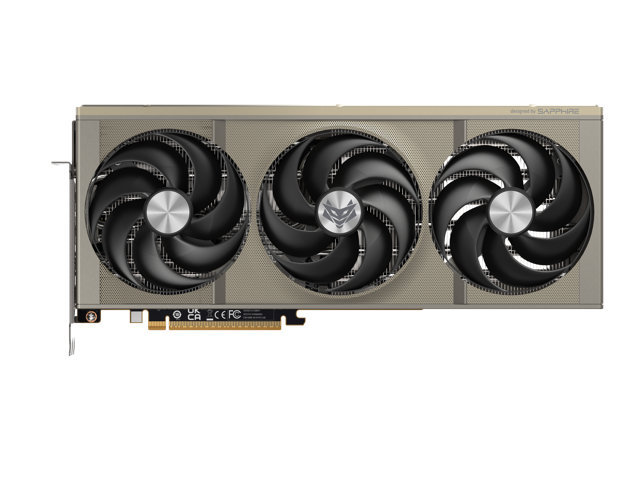Conclusion
Our review today evaluated the SAPPHIRE NITRO+ Radeon RX 9070 XT Gaming OC video card. This is the latest iteration of the NITRO+ and also ushers in the launch of AMD’s new RDNA 4 graphics card lineup. As far as we know, this will be the top card in the lineup for AMD. Notwithstanding, it also represents SAPPHIRE’s top card as well with an MSRP of $729.
The SAPPHIRE NITRO+ Radeon RX 9070 XT is a premium product, and the fit and finish are excellent. The video card has introduced the 12V-2×6 power connector to AMD’s lineup (for better or worse) and features an innovative magnetic backplate and cable routing system. There is just enough RGB to make it interesting, and you can sync that to your motherboard if you wish (when the software is working).
The SAPPHIRE NITRO+ Radeon RX 9070 XT has a factory overclock of 3060MHz and pushes the TDP/TGP to 330 Watts. It is supplied with 16GB of GDDR6 memory. What really sets the card apart is the unique custom design from SAPPHIRE, with a very striking look and feel and unique features. This is truly the cream de la crème of the Radeon RX 9070 XTs from SAPPHIRE.
Overclocking and Performance
Overclocking the SAPPHIRE NITRO+ Radeon RX 9070 XT Gaming OC was a bit of a challenge. Due to the fact this video card is brand new, finding the starting point with the RDNA 4 architecture has been interesting- a lot of trial and error. Our results seem to indicate that SAPPHIRE has put everything they can into finding the optimal factory overclock, literally everything and the kitchen sink.
This means the video card is operating near its top-performance out-of-the-box, so you are getting the most from it already, but that also means there is less headroom for enthusiast tweaking. It also seems that the power limit is the limiting factory for Radeon RX 9070 XT overclocking. The reference power limit is 300 Watts; our NITRO+ has a power limit listed at 330 Watts, and raising the power limit gives us 360 Watts.
Gaming Performance was a bit of a mixed bag of results. The SAPPHIRE NITRO+ Radeon RX 9070 XT bested the last generation AMD video cards in all seven games using plain raster. The margin, on average, was 10.7% over the AMD Radeon RX 7900 XT and 28.4% over the PowerColor Hellhound Radeon RX 7900 GRE. Of course, some results were higher, some lower, but all in all, that was a pretty good showing.
In looking at the newly released NVIDIA RTX 5070 Ti Founders Edition comparisons, the results were surprising. In four of seven games, the SAPPHIRE NITRO+ Radeon RX 9070 XT was even with or bested the NVIDIA RTX 5070 Ti FE. The victory margins were small, though, and the losses were bigger. That was enough to give the NVIDIA GeForce RTX 5070 Ti FE a 6% overall better performance in straight raster.
Ray Tracing was simply another chapter in the dominance of NVIDIA RTX-based graphics cards. The NVIDIA GeForce RTX 5070 Ti FE dominated ray tracing by over 28%. In Cyberpunk, the result was close and the game playable without upscaling. Unfortunately, three of the four games we used were unplayable without upscaling. Even then, two of the four were unplayable with upscaling.
In this category of gaming, we are seeing the same results played out over and over. The Radeon side of things just can’t catch up in ray tracing. We did look back through our library of video cards, and the SAPPHIRE NITRO+ Radeon RX 9070 XT is at about the NVIDIA GeForce RTX 3090 level of performance at present. The performance of the SAPPHIRE NITRO+ Radeon RX 9070 XT versus the last generation 7900 XT and 7900 GRE is a blow-out, seeing roughly 40% better FPS. Unfortunately, 40% better than dismal is still not very good. It doesn’t mean you can’t experience ray tracing using the SAPPHIRE NITRO+ Radeon RX 9070 XT. You will simply have to turn the settings down…..maybe a lot.
Final Points
Today marks the launch of a brand new group of video cards under the AMD banner. We looked at the SAPPHIRE NITRO+ Radeon RX 9070 XT Gaming OC. This top-of-the-line card from Sapphire is no doubt a premium build. It has several innovative features and, for the first time, uses the 12V-2×6 power adapter.
There isn’t much left as far as overclocking goes, as SAPPHIRE has put everything they can under the hood. The performance in plain RASTER gaming is quite good and competes with the more expensive NVIDIA GeForce RTX 5070 Ti FE pretty hard, hard enough to be as good or better in four of seven games. In ray tracing, the woes continue. Not good enough, plainly said. Yes, the Radeon RX 9070 XT was better than two cards from the last generation by quite a bit. Unfortunately, we are still way behind the leader.
All in all, the SAPPHIRE NITRO+ Radeon RX 9070 XT is a very well-built video card, it plays games well at 1440p (quite well, actually), and with ray tracing, you’ll have to use FSR Upscaling in demanding games. The price is pretty good for what you get, which may save the day here. The price coming in under the GeForce RTX 5070 Ti is a pretty big deal when you take a close look at the gaming results. It will be important to keep an eye on pricing over time and see how it all shakes out.
The SAPPHIRE NITRO+ Radeon RX 9070 XT offers a value proposition over the more expensive GeForce RTX 5070 Ti. SAPPHIRE has put everything in the NITRO+, and if you simply want a higher factory overclocked Radeon RX 9070 XT with a higher TDP than the base reference 9070 XT model, the SAPPHIRE NITRO+ Radeon RX 9070 XT really does take it to the next level at a price that makes sense in the current market.


